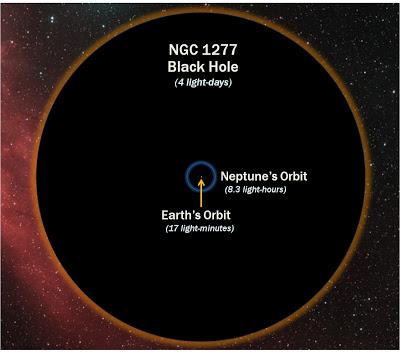

| Visitors Now: | |
| Total Visits: | |
| Total Stories: |

| Story Views | |
| Now: | |
| Last Hour: | |
| Last 24 Hours: | |
| Total: | |
Supermassive Blackhole with 17 billion solar mass has 14% of the mass of its galaxy
From
Astronomers have used the Hobby-Eberly Telescope at The University of Texas at Austin's McDonald Observatory to measure the mass of what may be the most massive black hole yet — 17 billion Suns — in galaxy NGC 1277. The unusual black hole makes up 14 percent of its galaxy's mass, rather than the usual 0.1 percent. This galaxy and several more in the same study could change theories of how black holes and galaxies form and evolve.
NGC 1277 lies 220 million light-years away in the constellation Perseus. The galaxy is only ten percent the size and mass of our own Milky Way. Despite NGC 1277's diminutive size, the black hole at its heart is more than 11 times as wide as Neptune's orbit around the Sun.
“This is a really oddball galaxy,” said team member Karl Gebhardt of The University of Texas at Austin. “It's almost all black hole. This could be the first object in a new class of galaxy-black hole systems.” Furthermore, the most massive black holes have been seen in giant blobby galaxies called “ellipticals,” but this one is seen in a relatively small lens-shaped galaxy (in astronomical jargon, a “lenticular galaxy”).
This diagram shows how the diamater of the 17-billion-solar-mass black hole in the heart of galaxy NGC 1277 compares with the orbit of Neptune around the Sun. The black hole is eleven times wider than Neptune's orbit. Shown here in two dimensions, the “edge” of the black hole is actually a sphere. This boundary is called the “event horizon,” the point from beyond which, once crossed, neither matter nor light can return. Credit: D. Benningfield/K. Gebhardt/StarDate
Nature – An over-massive black hole in the compact lenticular galaxy NGC 1277
See more and subscribe to NextBigFuture at 2012-11-30 10:42:12 Source: http://nextbigfuture.com/2012/11/supermassive-blackhole-with-17-billion.html
Source:



